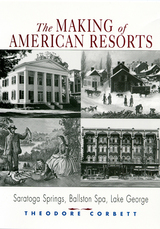2 books about Saratoga Springs

Lord, Please Don't Take Me in August
African-Americans in Newport and Saratoga Springs, 1870-1930
Myra B. Young Armstead
University of Illinois Press, 1999
In the late nineteenth and early twentieth centuries, northern resort towns were in their heyday as celebrated retreats for America's wealthy. "Lord, Please Don't Take Me in August" documents the experiences of African Americans in Saratoga Springs, New York, and Newport, Rhode Island--towns that provided a recurring season of expanded employment opportunities, enhanced social life, cosmopolitan experience, and, in a good year, enough money to last through the winter.
Affirming that the decision to live in their tiny resort communities was conscious and deliberate, Myra B. Young Armstead shows how Afro-Saratogians and Afro-Newporters organized their rhythms, their routines, and their communities to create meaningful identities for themselves.
Living on streets close to their churches, developing social organizations that promoted their standards of gentility and respectability, and lobbying for wider opportunities, these African Americans actively shaped their lives within the structures and limitations imposed on them.
Armstead situates the resort town between the poles of the rural South and the large industrial cities of the North. She shows how these small northern towns, with their seasonal economic rhythms and domestic wage work, permitted an important continuity between rural and urban lifestyles and a path from rural South to urban North besides the jarring, disruptive journey that often ended in the ghetto.
"Lord, Please Don't Take Me in August" tells a story that is at once American and uniquely African American: a story of economic imperatives and enlarged social aspirations culminating in a season--June, July, and August--that brought blacks as close as they could get to the American Dream.
Affirming that the decision to live in their tiny resort communities was conscious and deliberate, Myra B. Young Armstead shows how Afro-Saratogians and Afro-Newporters organized their rhythms, their routines, and their communities to create meaningful identities for themselves.
Living on streets close to their churches, developing social organizations that promoted their standards of gentility and respectability, and lobbying for wider opportunities, these African Americans actively shaped their lives within the structures and limitations imposed on them.
Armstead situates the resort town between the poles of the rural South and the large industrial cities of the North. She shows how these small northern towns, with their seasonal economic rhythms and domestic wage work, permitted an important continuity between rural and urban lifestyles and a path from rural South to urban North besides the jarring, disruptive journey that often ended in the ghetto.
"Lord, Please Don't Take Me in August" tells a story that is at once American and uniquely African American: a story of economic imperatives and enlarged social aspirations culminating in a season--June, July, and August--that brought blacks as close as they could get to the American Dream.
[more]

The Making of American Resorts
Saratoga Springs, Ballston Spa, and Lake George
Corbett, Theodore
Rutgers University Press, 2001
What factors create a successful resort? How did the rise of lavish hotels and spas reflect the changing values of American society as the nineteenth century progressed? Historians have argued that resorts were created to meet the demands of a leisured social elite. Theodore Corbett offers a fresh, compelling argument, demonstrating that resorts created and re-created themselves to keep pace with changing times. Success came with anticipating demands, not just reacting to them.
Using an impressive variety of historical documents, Corbett focuses on the conditions underlying the rise—and the demise—of the resorts at Ballston Spa and Caldwell on Lake George. Both towns’ major landlord–developers saw tourism as only one vehicle that could lead to success. As a result of their divided policies, neither town invested in the proper infrastructure to make tourism an immediate succes. Both places were soon overshadowed by Saratoga Springs, which became the premier resort of the upper and middle class.
Due to complex interwoven influences, Saratoga Springs was able to supply the amenities needed to attract and retain the patronage of the well heeled. The town provided visitors with lavish hotels, parks, public squares, pleasure gardens, and convenient service alleys. Saratoga Springs also had a work force that was available for the five-month period per year that the spas were active. Corbett examines the history and participation of various ethnic groups in the resort’s service sector: African Americans, Irish, and Native Americans.
Corbett also stresses middle-class America’s emulation of the leisure habits of the English aristocracy. Even though these pursuits (hunting, fishing, horse racrting) were dominaterd by men, social rituals were dominated by women, and resorts that accommodated “public domesticity” thrived as the century progressed. The Making of American Resorts offers a window into shifting public values and the structure of commercial tourism.
[more]
READERS
Browse our collection.
PUBLISHERS
See BiblioVault's publisher services.
STUDENT SERVICES
Files for college accessibility offices.
UChicago Accessibility Resources
home | accessibility | search | about | contact us
BiblioVault ® 2001 - 2024
The University of Chicago Press









